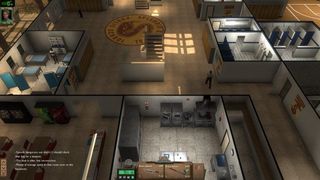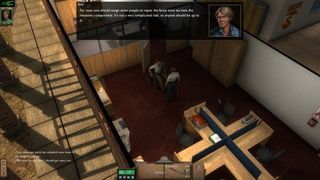Dead State alpha review

Davis is becoming a problem. The sandy-haired survivor has been whining at me to finish building the chain-link fence around our stronghold, an abandoned elementary school. To me, the fence is old-hat, low priority. “Relax,” I think, “The fence can wait for another day. The four of us are about to finish rebuilding the old well out back, and then we can ride out this whole zombie apocalypse business with fresh, clean water on tap.”
The next day, when shambling corpses overrun the school and kill us all, Davis has the decency not to scream “I told you so” with his final breath.
There are so very many ways to end up dead in Dead State: The First Seven Days. This early chunk of the game includes the introduction, the terrifying first scavenging missions, and, most importantly, getting to know your fellow survivors.
Getting to know you
Dead State is an interpersonal politics simulator as much as a party-based zombie RPG. While safely at the school, I became a den mother to the lost and left behind. Conversing with these characters reveals that what they'd really like—what would make this whole thing bearable—is a bar of deodorant. Chocolate. A magazine to read. These optional pieces of loot weigh on your mind during missions: I don't really need to raid that bookstore and risk the dead shopkeeper inside, but how much happier would everyone be with some new books? Is it worth the risk?

These personalities clash as the situation gets worse. After my first scavenging party to a nearby hardware store, one distraught character told me not to take her mother out on missions anymore. She's seen so many people lose their family already, she says, and she can't take the stress of worrying about her mom out on the road. Now I'm faced with a political choice: anger the daughter by bringing the mother with me, or calm the daughter and give up a crucial resource in the mother. Dead State's focus on character conflict during an emergency is an angle I haven't seen outside of The Walking Dead 's heavily scripted cut-scenes. Unlike the Telltale series, Dead State's conflicts can be solved by open-world exploration and looting, and that was a new experience for me.
Seven days later
Comic deals, prizes and latest news
Sign up to get the best content of the week, and great gaming deals, as picked by the editors.
Leaving the school, however, is rough in Dead State's current Early Access stage. Placeholder audio (or, at least, what I'm hoping is placeholder audio) marks zombie encounters with lo-fi roars and squishes. Alternate attacks for some melee weapons don't work, and trying to use them wastes action points and ends the turn. Every fight is dangerous, so missing turns gives corpses and looters an extra try to pull your organs out.
The weapons are also poorly balanced: a shotgun to the chest and a baseball bat to the skull do roughly the same amount of damage, but the shotgun will bring every corpse in 100 yards down on top of you, so there's no benefit in using it.

Combat in close quarters like storage rooms and suburban bedrooms is a pain thanks to a twitchy camera. With three characters, a grid-based map overlay, lootable objects, and enemies, these spaces become a crowded mess of colors and icons. Though the overhead camera can tilt and pan, it can't get a good view through walls and around bodies. I had numerous misclicks that sent my characters in the wrong direction or, worse, attacking each other instead of the approaching undead.
I also occasionally got stuck at the menu screen and had one crash to desktop. Though the game isn't finished, developer DoubleBear's aim for the First Seven Days release was a polished early piece of the game. This is not polished, and that makes me worry about the quality of the full release.
Beneath the bugs and quirks, though, the First Seven Days churns out compelling personal stories. Because it rewards you for completing missions and not for braining zombies, sometimes the best strategy is to sneak past enemies and quietly break into target buildings. In my favorite encounter, I ran into hostile looters while scouring a pharmacy for antibiotics. After killing two of them, the third drew a pistol and started shooting. We quickly overpowered her, but the shots attracted all of the zombies we'd so far avoided. As a dozen zombies stumble-walked down the pharmacy aisle toward the source of the noise, we grabbed the antibiotics, snuck out the back door, and ran like our hair was on fire.
As it stands now, the $25 buy-in for the First Seven Days isn't enough of a price cut (a $5 discount off of the final release) for a build of the game with a lot of problems left to fix. As much as I enjoyed the story Dead State starts to tell, the work-in-progress combat and game-ending bugs don't deserve your money right now.
Verdict: Wait and See

A promising early build beset by bugs, Dead State: The First Seven Days has potential but needs a lot of work before it's ready.
This review is based on the current alpha build of the game.
We will re-review this game once it is complete.
Most Popular






